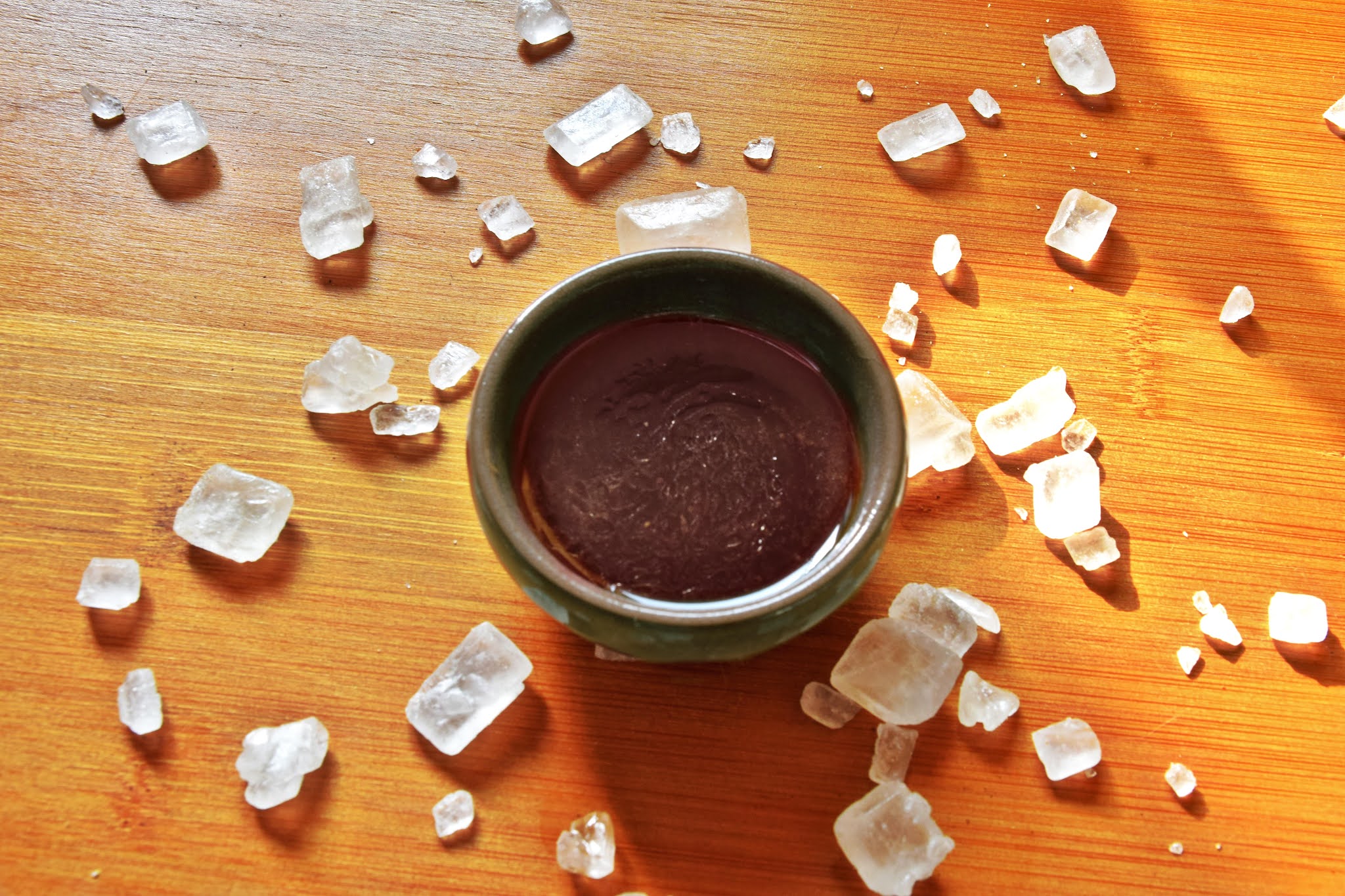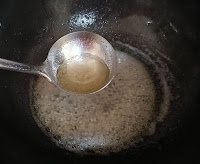The Ultimate Guide to Sichuan Sugars, Caramels, and Syrups
Sichuan Tang he Tangse (四川糖和糖色)
Add a delicious candy coating, enrich a stock, or add color to your dish by using this simple guide to Sichuan sugars and syrups.
Directions can be found later on how to cook various types of syrups, but first it's important to know the types of sugar used in Sichuan and Chinese cuisine. These include Rock Sugar, Granulated Sugar, and Brown Sugar among many others. However, these three types will be our primary focus.
Rock Sugar: There is Unrefined Rock Sugar (土冰糖), which has a yellowish hue, and Refined Rock Sugar (精制糖), which is clear and nearly colorless. Refined Rock Sugar melts faster because of its purity, has a pure sugar flavor, and is best for making syrups like in the recipes below. Unrefined Rock Sugar is yellow, has a cane sugar flavor, possesses more nutrients, and is great for making congee (rice porridge), sweet tea, and sweet hot water.
Granulated Sugar: This is just Rock Sugar that has been crushed or ground into small crystals or powder. However, in China, the bags of Ground White Sugar that one may purchase in a store are not always pure. Because of this many chefs insist on using Refined Rock Sugar when making syrups because they can control the purity. Certain Granulated White Sugars are cut with other ingredients such as a clear plastic-like flavorless ingredient. So, in China, it's sometimes best to use Refined Rock Sugar for syrups and only use Granulated White Sugar as a seasoning for stir-fries or dishes where purity is unimportant. Unrefined Granulated Sugar can be used the same as Unrefined Rock Sugar with the advantage that it dissolves easier.
Brown Sugar: There are two main types of Chinese brown sugar. The first is called Pian Tang (片糖) which is like a block of molasses flavored sugar. The other is called Hong Tang (红糖), which literally means red sugar and is essentially just dark brown sugar. Pian Tang comes in hard, dense bricks and is easier to store because it doesn't absorb moisture as readily as Hong Tang, which usually comes loosely packed inside a plastic bag. Pian Tang melts slower than Hong Tang and is used in many Cantonese desserts. Hong Tang is more often used in Sichuan desserts than Pian Tang. Furthermore, Hong Tang bubble milk tea (红糖珍珠奶茶) can be found all over China and is delicious and addicting.
Refined White Sugar can be used to make numerous candy coatings and syrups. These include Frosted (挂霜), Candied (拔丝), Hard Candied (冰糖), Significant Syrup (能指), and Colored Syrup (糖色).
Frosted (挂霜 Guashuang): The first stage of cooking sugar is called Guashuang. This is when the sugar has fully dissolved into syrup and all water has evaporated. While it is the first stage, it might be one of the more difficult to maintain. This is because it's easy to overcook the syrup and reach the next stage. Therefore, when wanting to make Guashuang dishes, be very careful not to overcook the syrup. Use low heat and a lot of patience. As soon as the syrup boils and little bubbles form, turn off the heat and stir in the ingredients. Guashuang can be used to make numerous frosted treats such as Frosted Peanuts (挂霜花生).
Candied (拔丝 Basi): By cooking the syrup a little longer, it will change color and become a brownish yellow. The syrup will be sticker at this point and, as it cools, create long silky-looking strands of stringy sugar. To enhance this stringiness and create longer threads, add about a tablespoon of vegetable oil to the syrup before mixing in the main ingredient. Basi can be used for making Candied Peanuts (拔丝花生) and Candied Sweet Potato (拔丝地瓜).
Hard Candied (冰糖 Bing Tang): If you continue cooking the syrup until it reaches an amber brown color, you can use this for coating various fruits. In China, there are many popular street food vendors who use this hard candied coating on fruit such as Hard Candied Pears (冰糖梨子) and Hard Candied Hawthorns (冰糖葫芦). Please note that the hotter the syrup the thinner the coating, so it's best to pour the hot syrup over the fruit several times to create even layers of candy coating.
Significant Syrup (能指 Nengzhi): This is more of an intermediate stage before adding water and creating Colored Syrup (糖色). By cooking the sugar until it deepens in color, you can create a thick purplish red syrup. There are not many uses for this syrup as is, but once you add water, it becomes a staple of numerous Chinese dishes.
Red Colored Syrup (糖色 Tangse): This Colored Syrup (literally: Sugar Color) is achieved by adding ample amounts of water to Nengzhi Syrup. Once water is added, the syrup color lightens to a bright red and loses all sweetness. Instead, it will have a very subtle richness. This syrup can be stored for weeks or even months in an airtight jar without spoiling. It’s simply sugar, water, and oil. Since Colored Syrup is integral to making Red Braised Dishes, make a good amount ahead time (you can even double the following recipe) and store in a cabinet, ready to use in incredible dishes like Red Braised Pork Belly (红烧肉) and Red Braised Beef (红烧牛肉).
Ingredients
1 cup Refined Rock Sugar (Crushed into Fine Granules)
1 cup Water
1 Tbsp Vegetable Oil
Directions
1.) Mix the Sugar, Water, and Vegetable Oil in a bowl.
2.) Heat a seasoned wok on high until hot, reduce to medium-low heat, and then add the Sugar mixture stirring constantly. As soon as the Syrup boils reduce the heat to low.
3.) Cook stirring constantly until the Sugar has dissolved, lots of tiny bubbles form on the surface, and the Water has mostly evaporated. Once the water has the evaporated, the Syrup has reached its first stage: Frosted (挂霜 Guashuang).
4.) For the next stage, continue cooking until the Syrup has changed color slightly to a light toasty yellowish brown similar to sesame oil. Once the color has changed, the Syrup is now at its second stage: Candied (拔丝 Basi).
5.) Cook the Syrup slightly longer, stirring constantly, until the color becomes a rich caramel. The Syrup has now reached its third stage: Hard Candied (冰糖 Bing Tang).
6.) Continue cooking while stirring constantly until the Syrup darkens to one more shade of reddish brown and cut off the heat. Use the remaining heat in the wok to finish cooking the Syrup, which will change from a reddish brown to more of a purplish red. Once the Syrup is a beautiful purplish red, it has reached its final stage: Significant Syrup (能指 Nengzhi).
(Removing the Syrup from heat at this point will prevent it from acquiring a burnt taste. BUT even if the Syrup has a little of this burnt taste, don’t panic. This is normal and many chefs will still use this Syrup, because the burnt flavor won’t affect the flavor of the final dish. However, if the Syrup has significantly blackened and after adding water the Syrup has an overpowering burnt flavor, do not use it. It’s best to start over and try again).
7.) Add about 2 cups of boiling Water – or, about twice the amount of Water to Syrup – and mix until thoroughly combined. Cook for 1 minute and pour the Syrup into a large bowl to cool.
(DO NOT use cold water! The hot syrup can splash if cold water is added. This Syrup is called Colored Sugar (糖色 Tangse) or more accurately Red Colored Syrup; it should be nearly tasteless and have a bright red color).
8.) Once cool, pour the Colored Syrup into a jar with an airtight lid in which it can be long-term and used as needed.
(Red Colored Syrup should store well and not spoil. However, since it is made of water and oil, some of the oil may separate in a thin layer on top. This is normal. Simply shake the jar to emulsify the contents prior to use).
Contribute to Sichuan Soul
Sichuan Soul is funded in part thanks to generous contributions by fans like you! Your donations supply Sichuan Soul with the funding needed to provide quality recipes and photos. All donations are processed safely and securely through PayPal. You can donate any amount using the 'Donate' button below. Thank you for your support.




Comments
Post a Comment